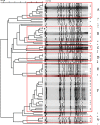Incidence of and risk factors for infection or colonization of vancomycin-resistant enterococci in patients in the intensive care unit
- PMID: 23071778
- PMCID: PMC3468570
- DOI: 10.1371/journal.pone.0047297
Incidence of and risk factors for infection or colonization of vancomycin-resistant enterococci in patients in the intensive care unit
Abstract
The prevalence of vancomycin-resistant enterococci (VRE) colonization or infection in the hospital setting has increased globally. Many previous studies had analysed the risk factors for acquiring VRE, based on cross-sectional studies or prevalent cases. However, the actual incidence of and risk factors for VRE remain unclear. The present study was conducted in order to clarify the incidence of and risk factors for VRE in the intensive care unit (ICU). From 1(st) April 2008 to 31(st) March 2009, all patients admitted to a surgical ICU (SICU) were put on active surveillance for VRE. The surveillance cultures, obtained by rectal swab, were taken on admission, weekly while staying in the SICU, and on discharge from the SICU. A total of 871 patients were screened. Among them, 34 were found to carry VRE before their admission to the SICU, and 47 acquired VRE during their stay in the SICU, five of whom developed VRE infections. The incidence of newly acquired VRE during ICU stay was 21.9 per 1000 patient-days (95% confidence interval [CI], 16.4-29.1). Using multivariate analysis by logistic regression, we found that the length of ICU stay was an independent risk factor for new acquisition of VRE. In contrast, patients with prior exposure to first-generation cephalosporin were significantly less likely to acquire VRE. Strategies to reduce the duration of ICU stay and prudent usage of broad-spectrum antibiotics are the keys to controlling VRE transmission.
Conflict of interest statement
Figures
References
-
- Schooneveld TV, Rupp ME (2010) Control of Gram-positive multidrug-resistant pathogens. In: Lautenbach E, Woeltje KF, Malani PN, editors. Practical healthcare epidemiology. 3rd ed. Chicago, United States: The university of chicago press. 197–208.
-
- Noble WC, Virani Z, Cree RG (1992) Co-transfer of vancomycin and other resistance genes from Enterococcus faecalis NCTC 12201 to Staphylococcus aureus. FEMS Microbiol Lett 72: 195–198. - PubMed
-
- Chang S, Sievert DM, Hageman JC, Boulton ML, Tenover FC, et al. (2003) Infection with vancomycin-resistant Staphylococcus aureus containing the vanA resistance gene. N Engl J Med 348: 1342–1347. - PubMed
-
- Vergis EN, Hayden MK, Chow JW, Snydman DR, Zervos MJ, et al. (2001) Determinants of vancomycin resistance and mortality rates in enterococcal bacteremia. A prospective multicenter study. Ann Intern Med 135: 484–492. - PubMed
-
- Edmond MB, Ober JF, Dawson JD, Weinbaum DL, Wenzel RP (1996) Vancomycin-Resistant Enterococcal Bacteremia: Natural History and Attributable Mortality. Clinical Infectious Diseases 23: 1234–1239. - PubMed
Publication types
MeSH terms
LinkOut - more resources
Full Text Sources
Miscellaneous


